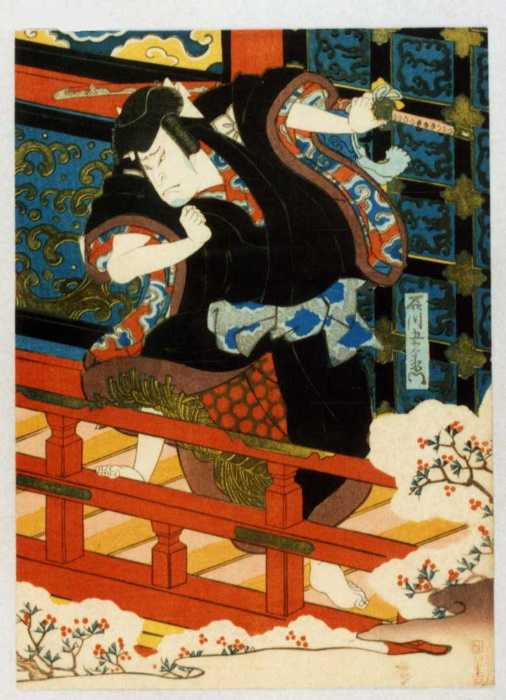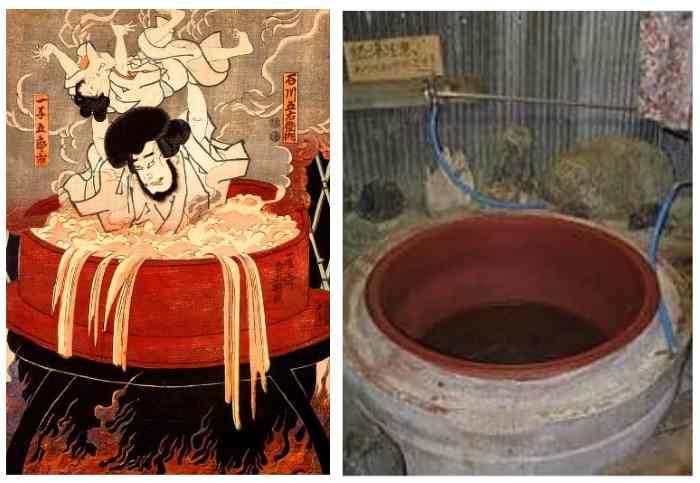Ishikawa Goemon 石川 五右衛門 He Stole from the Rich to give to the Poor

One of the most enigmatic and interesting characters in Japanese history. His deeds are mixed between documented real facts and legends that transformed Ishikawa Goemon into the Japanese Robin Hood, the one who stole from the rich to give to the poor.
Lived during the Sengoku-jidai era (1467-1603), Ishikawa Goemon (石川 • 五 右衛門) was a ninja warrior who became a thief that stole gold and precious objects for donated them to the poor.The first historiographic appearances of the character date back to 1642 when in a biography of Toyotomi Hideyoshi he is mentioned several times, he was described as an outlaw who stole precious objects, but with a particular characteristic, the gift to the poor of the spoils.
Crossing the sources we can find the same information on different diaries of some Jesuits (who attempted the evangelization of the country at that time) where a man who stole with the intention of giving to the most needy is mentioned. Among the exploits that distinguished him was also attributed an alleged assassination attempt against Oda Nobunaga.
Born in the province of Iga-no-kuni (now Mie-ken) on August 24, 1558 from a samurai family serving the Miyoshi-shi, in 1573 at the age of fifteen he saw his father Ishikawa Akashi assassinated by some men of the Ashikaga-uji clan (who also killed the mother), after those tragic events, began to learn the art of ninjutsu under the guidance of master Momochi Sandayū. He was later forced to flee when the master discovered the relationship of the young ninja had with one of his lovers (but before he stealing a precious sword). He moved to Kansai-chihō (the Kansai region) where he formed and led a gang of outlaws who robbed merchants and wealthy feudal lords by sharing the spoils with the oppressed peasants. According to another narrative, he started his outlaw career after the failure of the attempted murder of Oda Nobunaga, forcing him to live as a fugitive.
What is most remembered, however, was the attempted assassination of Toyotomi Hideyoshi, also having no precise sources, this gesture can be traced mainly to two reasons. A hypothesis leads us to follow the path of revenge for the death of his wife Ōtaki and for the capture of the son Gobei. While according to another historical reconstruction it was the opponents of Daimyō himself who commissioned the murder. He then went to Fushimi-jō (Fushimi Castle also known as Momoyama Castle) near Kyōto-shi and entered Hideyoshi's room, but inadvertently dropped a bell from the table and the noise attracted the guards who captured him. Subsequently tried he was sentenced to death 9 October 1594, put in an iron cauldron with boiling oil together with his son who tried to save up to the last while holding it over his head, when he was now about to succumb to the terrible burns, some judges decided to save the child's life.

At the Daiun-in (Buddhist temple) located in Kyōto-shi there is a plaque in his memory, while in a room of the same temple there is a 「Goemonburo」 (which literally means: Goemon Bath) that became famous in the years no longer as a death tool but like the traditional bathtub (in wood or iron) where the water was heated directly by the flames of a fire that is at the base, while at Nanzen-ji (also in Kyōto-shi) there is a his statue near the temple.
Ishikawa Goemon is the subject of many kabuki works including the most famous: 「Sanmon-Gosan-no-Kiri」 written in 1778 by Namiki Gohei. To these are added numerous films, videogames, anime and manga where the "good" thief is the main character. Without doubt the most famous reference of all is the tribute made by the great and late mangaka Monkī Panchi (real name Katō Kazuhiko) where Jūsandaime Ishikawa Goemon is even the thirteenth descendant of the historical character, the same Zantetsu-ken, the famous sword used by the friend of Rupan Sansei (Lupine III) is a clear reference to the precious katana that Ishikawa Goemon used.

In 1992, in a series of stamps dedicated to kabuki, you could find some sheets where Ishikawa Goemon was present as it is often represented in the works dedicated to him.
I want to thank our friend and collaborator, Paolo Napolitano, who left us this very interesting post on a figure in Japanese history that few actually know about.

 English (United Kingdom)
English (United Kingdom)  Italiano (it-IT)
Italiano (it-IT) 






![[Review] Princess Toyotomiプリンセス トヨトミ](https://www.fukainihon.org//cache/mod_jt_contentslider/fdfb524f85518b9476158c79c8ea022f_328.png)


